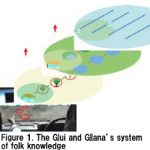The purpose of this research is to explore the question of how the San and the Pygmies, typical hunter-gatherers in Africa, have been involved with and are related to the natural and social environment within the contact zones of their neighboring agro-pastoralists, whilst also making this point correlate with another question as to how they have constructed their collective identities. Namely this research aims to depict the natural and cultural history of their landscape formation.
To realize this purpose, materials regarding three local activities, these being seeing, walking, and speaking will be collected and analyzed from three geographical locations, namely central Botswana, north-central Namibia, and south-east Cameroon.
Furthermore, this data will be compared and considered to reveal the cultural structure, which characterizes the relationships between hunter-gatherers and agro-pastoralists in Africa.

1. Seeing: Seeing is a social action. When we see the environment, we classify it using a specific language, which has been historically and culturally constructed, focus on its specific aspects that have been socially situated, and express it to others through embodied practices (C. Goodwin 1994). For example, the G|ui and the G||ana fuse “nature” with “culture” using their system of folk knowledge (Figure 1), which handles various scales within their living sphere (Research Achievement 2, 7, 36, 37). Under this theme, this research will clarify in each contact zone as to which part of the environment hunter-gatherers and agro-pastoralists see, in what way, and how they express it, and discuss the relationship between this point and the formation process of social events.
2. Walking: While this is easily overlooked, when we relate to the environment, we are most likely moving. Walking is also the most basic transportation means for many hunter-gatherers and it is also a movement that characterizes their livelihood style. For example, in order to understand the characteristics of the G|ui and G||ana’s excellent environmental perception, they must be analyzed in the context of wayfinding practices on foot and hunting activities (Research Achievement 1, 15, 34, 35, 38, 39). Under this theme, this research will collect empirical data in each contact zone as to which part of the zone hunter-gatherers and agro-pastoralists walk and to what extent, and reveal as to what sort of habitats (composed of corporeal niche, physical niche, and other types of niches, and support education and learning of cultural values: Ochs et al. 2005) that the both groups of people form within their ecological environment.
3. Speaking: Speaking provides a framework for achieving mutual understanding in interaction, while at the same time it is placed within the context of a system that has been historically and culturally constructed. The analysis of speaking can help us understand how people’s social identities are fashioned and altered over time, social groups in the sense of collective agents are formed and unformed, and how, under conditions of inequality, social groups in the sense of collective agents are formed and unformed (Fraser 2003). For example, life histories of the !Xun indicate that, while they have been repeatedly peripheralized by the people and organizations surrounding them, they have controlled social conflicts with these people and organizations (Research Achievement 3, 29, 30). Under this theme, this research will clarify the history of relationships that hunter-gatherers and agro-pastoralists have constructed in each contact zone, and how the two parties understand this history. The research will then argue as to what prospects there may be in order to demonstrate their subjectivity within modern social change and current political practices.
MEXT Grant-in-Aid for Scientific Research (A) (Overseas Research
Survey) – “Natural and cultural history of landscape formation in
contact zones between hunter-gatherers and agro-pastoralists in
Africa”
Principal Investigator: Akira TAKADA (Associate Professor, Graduate
School of Asian and African Area Studies, Kyoto University)